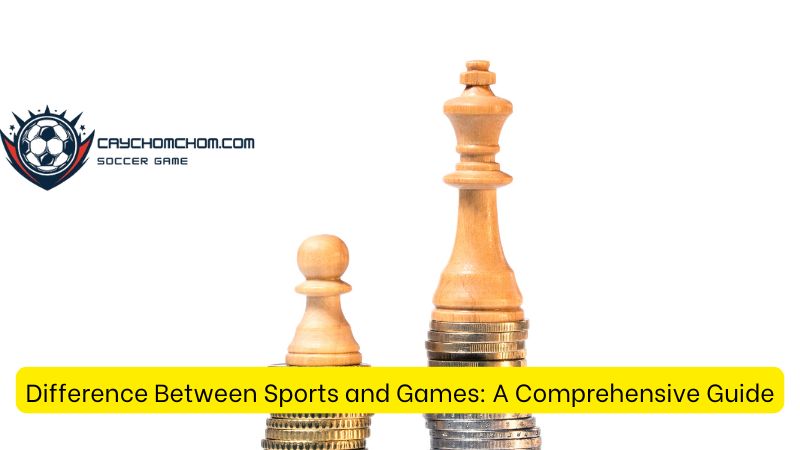The terms sports and games are often used interchangeably, but they represent distinct concepts. While both involve physical or mental activity, rules, and enjoyment, their scope, objectives, and cultural significance differ. Understanding the difference between sports and games can help clarify their unique roles in promoting physical fitness, mental acuity, and social interaction.
In this article, Cay Chom Chom will delve into the core distinctions between sports and games, explore their characteristics, and highlight their significance in modern life.
Defining Sports and Games
Before we dive into the differences, let’s define each term:
What Are Sports?
Sports are organized physical activities or competitions that involve individual or team participation. They require a combination of skill, physical effort, and strategy to achieve a defined objective, such as scoring points or crossing a finish line.
- Examples: Soccer, basketball, swimming, and tennis.
- Key Features: Competitive nature, physical exertion, structured rules, and professional leagues.
What Are Games?
Games are structured forms of play that may involve physical activity, mental effort, or both. They can be competitive or non-competitive and are often played for recreation or entertainment.
- Examples: Chess, Monopoly, video games, and hide-and-seek.
- Key Features: Focus on strategy, creativity, and fun, with varying levels of physical involvement.
Key Differences Between Sports and Games

Difference Between Sports and Games
Let’s break down the differences between sports and games across several dimensions:
1. Physical vs. Mental Focus
- Sports: Primarily involve physical exertion and athletic ability. While strategy and mental focus are essential, the emphasis is on physical performance.
- Games: Can range from physically active (like tag or dodgeball) to entirely mental (like chess or board games).
2. Competitiveness
- Sports: Highly competitive, often involving leagues, tournaments, and professional athletes. The outcome usually holds significant value for participants and fans.
- Games: Can be competitive or purely recreational. Some games, like esports or competitive card games, bridge the gap by fostering professional competition.
3. Rules and Regulation
- Sports: Governed by standardized rules established by international or national organizations (e.g., FIFA for soccer, NBA for basketball).
- Games: Rules can be formal (e.g., in chess championships) or informal, allowing for flexibility and adaptation.
4. Professional Opportunities
- Sports: Offer professional careers, with athletes earning recognition, endorsements, and substantial income.
- Games: While many are recreational, some (like esports and poker) provide professional avenues and competitive earnings.
5. Cultural and Social Significance
- Sports: Often associated with national pride, cultural identity, and mass appeal. Events like the Olympics or FIFA World Cup unify nations and communities.
- Games: Typically smaller in scale and focused on personal or group entertainment rather than global impact.
6. Physical Settings
- Sports: Require dedicated facilities such as stadiums, fields, or courts.
- Games: Can be played almost anywhere—at home, in parks, or even online.
7. Duration
- Sports: Usually have fixed durations (e.g., 90 minutes for soccer, four quarters for basketball).
- Games: Can range from a few minutes to several hours, depending on the type and complexity.
Similarities Between Sports and Games
While sports and games differ in many ways, they share commonalities:
- Rules and Objectives: Both are governed by rules that guide how they’re played and determine the winner.
- Skill Development: Sports and games improve various skills, such as coordination, strategic thinking, and teamwork.
- Enjoyment: Both are pursued for entertainment, relaxation, or social interaction.
- Health Benefits: Both promote physical or mental well-being, depending on the activity.
Examples Highlighting the Differences
Sports Examples
- Soccer: A globally popular sport that requires physical endurance, teamwork, and tactical play.
- Tennis: An individual or doubles sport focusing on speed, precision, and skill.
- Swimming: A purely physical sport emphasizing stamina, technique, and speed.
Games Examples
- Chess: A strategic board game requiring mental acuity and foresight.
- Tag: A childhood favorite that blends physical activity with fun.
- Video Games: Digital games that engage players in virtual worlds with varying degrees of challenge and competition.
The Evolution of Sports and Games
Traditional Origins
- Sports have ancient roots, with activities like wrestling, running, and archery dating back thousands of years. They often evolved from survival skills or rituals.
- Games, such as dice or board games, originated as forms of entertainment and social bonding.
Modern Developments
- Sports have professionalized over time, with advancements in training, technology, and global reach.
- Games have embraced digital transformation, leading to the rise of esports and online gaming communities.
Integration of Technology
- In sports, technology aids in performance tracking, refereeing, and broadcasting.
- In games, digital platforms and virtual reality have expanded possibilities, making them more immersive and interactive.
Benefits of Sports and Games
Sports Benefits
- Physical Health: Enhances cardiovascular fitness, strength, and endurance.
- Teamwork: Builds leadership and cooperative skills.
- Stress Relief: Physical activity releases endorphins, reducing stress and boosting mood.
Games Benefits
- Mental Agility: Develops critical thinking, problem-solving, and memory.
- Accessibility: Can be played by people of all ages and abilities.
- Creativity: Encourages imaginative thinking and innovation.
The Intersection: When Sports Become Games
Some activities blur the line between sports and games. For example:
- Esports: Competitive video gaming combines the mental focus of games with the structured competition of sports.
- Chess Boxing: A hybrid activity that alternates between boxing rounds and chess games, requiring both physical and mental prowess.
Tips for Choosing Between Sports and Games
- Consider Your Goals: If you seek physical fitness, opt for sports. For mental stimulation, choose games.
- Assess Your Environment: Sports often require specific facilities, while games can be played anywhere.
- Think About Time Commitment: Sports typically require more time and preparation than casual games.
- Mix It Up: Incorporate both sports and games into your routine for balanced physical and mental health.
Conclusion
Understanding the difference between sports and games helps appreciate their unique value in our lives. While sports focus on physical activity and competition, games emphasize strategy, creativity, and fun. Both contribute to holistic development and offer diverse ways to stay active, engaged, and connected.
Whether you’re scoring goals on the soccer field or strategizing your next move in chess, the choice between sports and games depends on your interests, goals, and circumstances. Embrace both to enjoy the best of both worlds!












